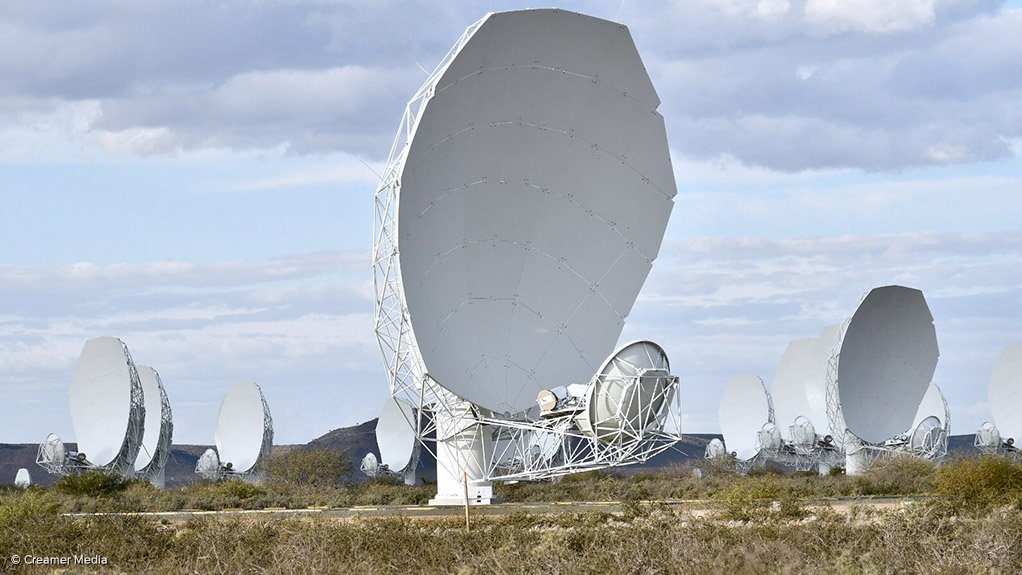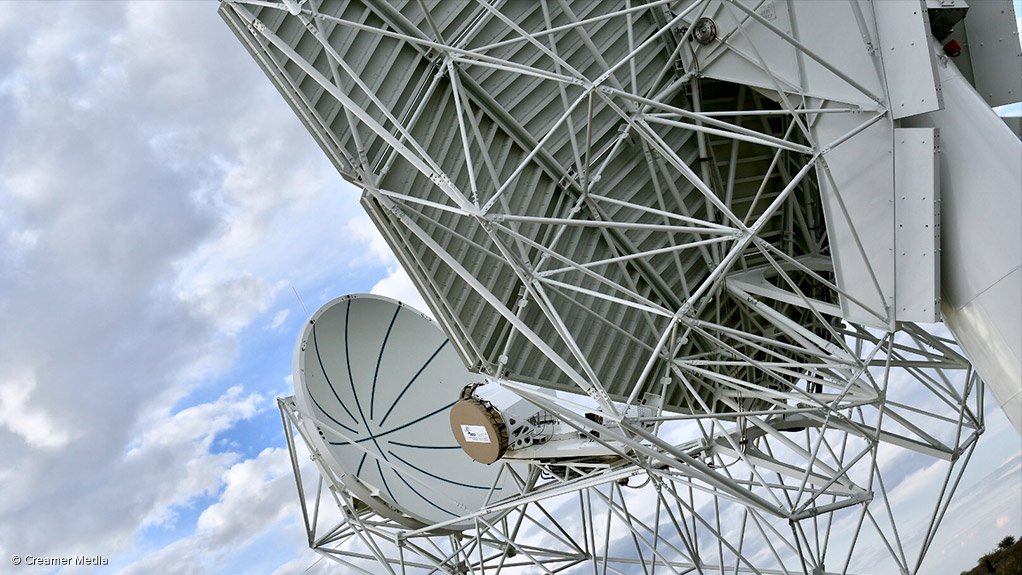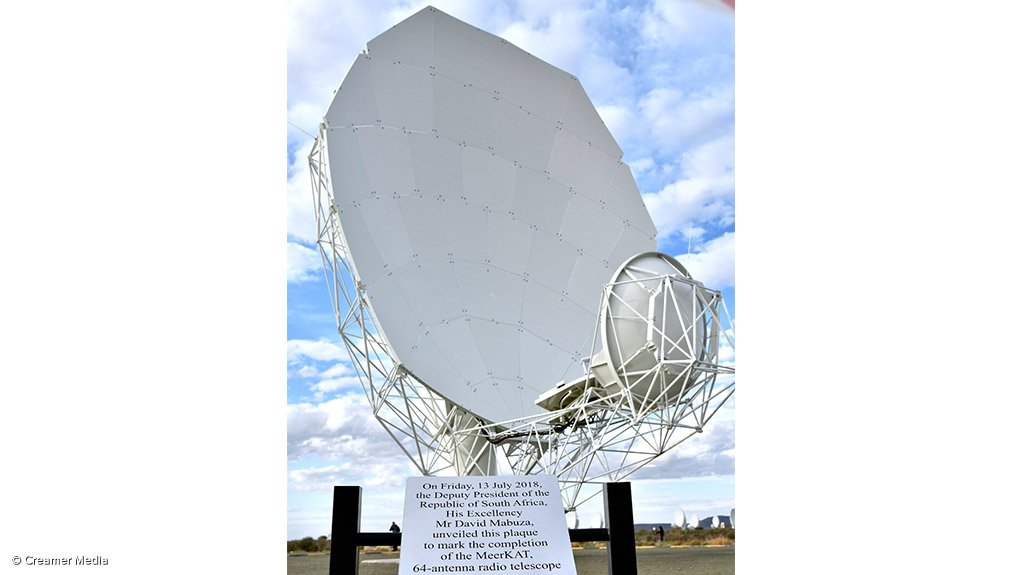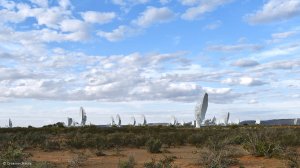After a decade in design and construction, the MeerKAT radio telescope, located about 90 km from Carnarvon in the Northern Cape, was inaugurated on Friday.
The MeerKAT is the precursor to the R10-billion Square Kilometre Array (SKA) – an international enterprise to build the largest and most sensitive radio telescope globally. Its infrastructure will be located in Africa and Australia.
The MeerKAT will be integrated into the mid-frequency component of SKA Phase 1 by 2020.
At the inauguration of the MeerKAT on Friday, which was officiated by Deputy President David Mabuza, a panorama obtained with the new telescope was unveiled that reveals extraordinary detail in the region surrounding the supermassive black hole at the centre of the Milky Way galaxy.
The MeerKAT radio telescope, which covers an area of about 1 km2, will unlock development in science and technology, said Mabuza.
Innovations and technologies, such as the MeerKAT, create a platform to enable future generations to learn, develop and innovate, he added, noting that this would, in turn, enable South Africa to move forward in terms of research, science and technology.
He further noted that collaborative projects, such as the MeerKAT, will unlock South Africa’s full research and development potential, responding to the challenges of the twenty-first century. He stated that future value creation lies in humans and machines working together to create new products, new services and new prospects.
The MeerKAT project allows South Africa to demonstrate to the world that “nothing is impossible, once we set our minds to a common objective and pool our resources to achieve such an objective”, he emphasised.
Also speaking at the event, Science and Technology Minister Mmamoloko Kubayi-Ngubane said the project is a major milestone, which puts South Africa at the frontier of the in-depth study of the universe.
Meanwhile, according to South African Radio Astronomy Observatory chief scientist Fernando Camilo, the centre of the galaxy is an “obvious target” for demonstrating the science capabilities of the new instrument.
The centre of the Milky Way, about 25 000 light years away, he explained, is unique, visually striking and full of unexplained phenomena. Lying behind the Sagittarius constellation, the centre of the Milky Way is “forever enshrouded by intervening clouds of gas and dust, making it invisible from earth using ordinary telescopes”.
However, the infrared, X-ray and radio wavelengths penetrate the obscuring dust and open a window into this distinctive region with its unique four-million solar mass black hole.
ABOUT MEERKAT
The MeerKAT radio telescope comprises 64 antennas, each about 13.5 m in diameter, located on baselines of up to 8 km.
The dishes are of a highly efficient design with up to four cryogenic receiver systems operating in different bands of the radio spectrum.
The first installed set of receivers operates between frequencies of 900 MHz and 1 670 MHz.
The vast amounts of data from the 64 dishes are processed at speeds of up to 275 Gb/s in real-time by a “correlator”, followed by a “science processor”, both purpose-built.
After further offline analysis, images of the radio sky are generated.
The primary industry partner in the manufacturing of the MeerKAT antennas Stratosat Datacom, leads a technology consortium including international partners US-based General Dynamics Satcom and Germany-based Vertex Antennentechnik.
At least 75% of the components making up the MeerKAT dishes have been manufactured in South Africa by several subcontractors.
Further, the construction of the MeerKAT, as well as surrounding infrastructure, has created about 7 284 employment opportunities to date, said Mabuza.
UK AID FOR AFRICAN RADIO ASTRONOMY
The Development in Africa with Radio Astronomy (DARA) project, a joint venture between South Africa, the UK and other African partner nations, aims to provide development, education, training and career advice to Africans in radio astronomy and related technical disciplines.
As Africa prepares to host the mid-frequency part of the global SKA radio telescope project, the UK is playing a key role in helping to train African radio astronomers.
The first phase of the SKA will see 133 dishes built in the Karoo desert of South Africa by 2026. These will join the 64 dishes of the MeerKAT array that have been completed, at the same location.
By around 2030, the second phase of the SKA is planned to extend its network of dishes into eight African partner countries, namely Ghana, Kenya, Zambia, Namibia, Botswana, Madagascar, Mozambique and Mauritius.
Spreading the dishes out like this is necessary to provide the long baselines of several thousands of kilometres that will deliver the combination of high spatial resolution and sensitivity needed for the ambitious science goals of the SKA.
WHY THE NAME?
The telescope was originally known as the Karoo Array Telescope (KAT) and was designed to comprise 20 receptors.
When the South African government increased the budget to allow for the construction of 64 receptors, the team renamed it MeerKAT, which translated from Afrikaans to English means 'more of KAT'.
The meerkat, or Suricata suricatta, is also a small mammal that lives in the Karoo region.
EMAIL THIS ARTICLE SAVE THIS ARTICLE ARTICLE ENQUIRY
To subscribe email subscriptions@creamermedia.co.za or click here
To advertise email advertising@creamermedia.co.za or click here

















